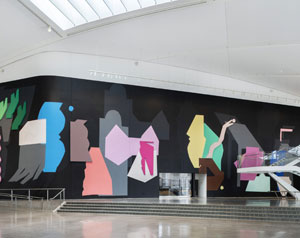1.22.25 — Crossing Borders
Oh, no, not another biennial or triennial. What could conceivably make this one any different? It is “Flow States,” La Trienal 2024 El Museo del Barrio through March 16. Will it just go with the flow?
A museum dedicated to the Americas in New York has a ready answer. It is all about cultural difference—and the borders meant to keep differences out. Not that La Trienal is a dry and affirming lecture on diversity. The artists themselves may wonder what to call home. With just thirty-three contributors, it leaves ample room to share in their dilemma.  With a dozen works commissioned for the occasion, it hopes to nurture them as well, and I work this together with past reports on Amalia Mesa-Bains and “Domesticanx” at the same museum as a longer review and my latest upload.
With a dozen works commissioned for the occasion, it hopes to nurture them as well, and I work this together with past reports on Amalia Mesa-Bains and “Domesticanx” at the same museum as a longer review and my latest upload.
Visitors cross more than one border just by entering. A black beaded curtain, by Cosmo Whyte, leads to rooms often reserved for a second show, but among the museum’s best for installations and big work. Whyte calls it Persona Non Grata, for not all are equally welcome in America. It leaves one face to face with a mural by Caroline Kent that takes her lively abstract shapes into a mix of painted and solid forms. It is, she explains, interdimensional. Borders, it appears, are for time travelers, too.
You may not even know that they are there. Nearby, Estaban Cabeza de Baca adopts the same mural scale for a tropical landscape. You might have settled in for vacation only to find yourself on the border between the United States and Mexico. Still other place markers are invisible, like bird calls from Mark Menjivar and scents from Chaveli Sifra. Paint for Ser Serpas (also in the 2024 Whitney Biennial) spills out from the walls and onto the floor, for an immersive experience. Trump’s wall is mostly a fiction anyway.
Artists have crossed borders personally as well, starting with their heritage. Kent has a Mexican mother and an African American father. Regardless, they surely sympathize with those who have made the crossing just to survive. Studio Lenca suspends migrant caps from pieces of a Ford F-150 truck. Liz Cohen photographs women workers, while Studio Lenca calls its paintings Journeys. Tony Cruz Pabón marks the distance from San Juan to New York with pencil marks that bring him closer to Minimalism than folk art.
They may cross borders with their materials as well. Carmen Argo constructs her beings from plastic ties and palm leaves, while Sarita Westrup applies native crafts to a good old New York traffic cone. Raw materials like tar take Karyn Olivier from carnival in Trinidad to shelter in North Philadelphia. Then too, borders are place markers. Joe Zaldivar maps where every artist has landed, in New York and behind. As curators, Rodrigo Moura, Susanna V. Temkin, and María Elena Ortiz fill the entire museum, as if mapping a continent.
These are unsettling journeys, whatever the artist’s cultural identity. This is not one big happy family. Alina Perez in charcoal remembers her family as anything but what she calls a Family Romance. Photos by Christina Fernandez remember long suburban nights in LA as a war zone. Mario Martinez uses light brushwork out of Abstract Expressionism to evoke every New Yorker’s favorite toxic Superfund site, the Gowanus Canal. Kathia St. Hilaire can pack almost anything into low relief, from banknotes and banana stickers to a painted candle piercing the darkness.
Artists here may shy away from from conflict or boosterism, but anger remains. “They stole our land and now they call us migrants,” a fisherman says in video by Alberta Whittle—and yet beauty remains in his labor and his nets. This translates into large work, and artists can easily coast on it. Smaller pieces and older media mostly fall short. Can a triennial, then, truly make a difference? Maybe so, but please do not ask for yet another.
Read more, now in a feature-length article on this site.